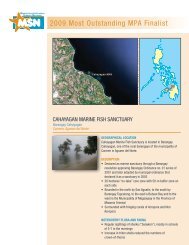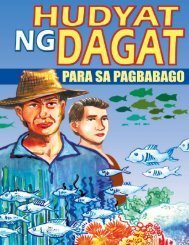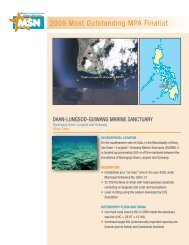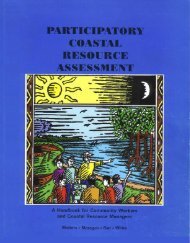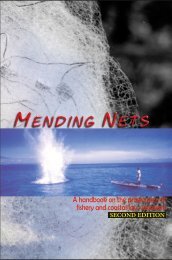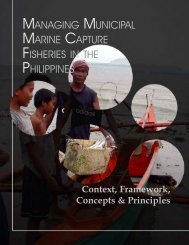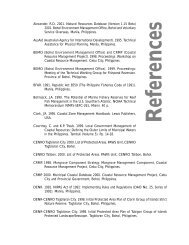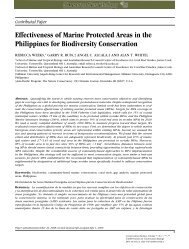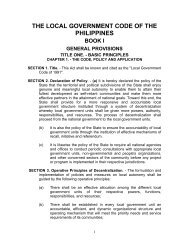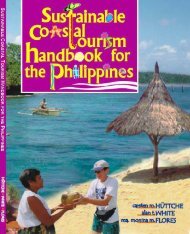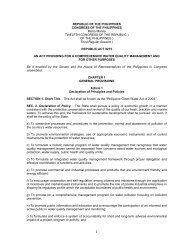3.9MB / Click here to download - Oneocean.org
3.9MB / Click here to download - Oneocean.org
3.9MB / Click here to download - Oneocean.org
You also want an ePaper? Increase the reach of your titles
YUMPU automatically turns print PDFs into web optimized ePapers that Google loves.
10 Rhythm of the Sea<br />
Under the classification system designed by the Department of Environment and<br />
Natural Resources (DENR) and the Department Agriculture (DA), land classified under<br />
sustainable land use is utilized in accordance with its suitability. Development opportunity<br />
land is utilized at a level of intensity that is below the suitable intensity. Land that is not<br />
sustainable is utilized at a level of intensity that is in excess of its suitability (AusAID<br />
1995).<br />
Much of the land within the profile area is classified as being either sustainably<br />
utilized, or underutilized (development opportunity land). The entire coastline of the profile<br />
area is currently classified as development opportunity land. This means that the land is<br />
currently being utilized at a level of intensity that is below the suitable intensity (as defined<br />
by the DA and DENR). Much of this development opportunity coastline is classified as<br />
being suitable for forestry plantation. The implication of this classification is that agroforestry<br />
projects (such as community-based mangrove stewardship) in the area can be<br />
stepped up <strong>to</strong> meet the livelihood needs of the coastal population.<br />
As of now, mangroves and marshes are the predominant feature in this underutilized<br />
area. Inland from the development opportunity fringe, t<strong>here</strong> are vast areas classified as<br />
sustainably used areas. This implies that the land is being utilized in accordance with its<br />
suitability. In this case, the majority of sustainable land is currently utilized for rice farming<br />
or fishpond development.<br />
Since a high percentage of the profile area's population is rural, the impact of<br />
human settlements upon the land is not considered <strong>to</strong> be high by local government officials.<br />
Currently, the majority of municipal urban centers sprawl across rice land and mangrove<br />
areas. This means that future urban growth (due <strong>to</strong> population pressure) will infringe upon<br />
the wetlands, causing sustainability <strong>to</strong> decrease as a result of human waste and pollution.<br />
The resulting loss of sustainability may cause drops in agricultural productivity, and further<br />
degrade the coastline.<br />
CLIMATE<br />
TE<br />
The climate of Bohol is characterized by 2 distinct seasons. The dry season occurs from<br />
late January <strong>to</strong> May, while the wet season is from June <strong>to</strong> December. Average annual<br />
precipitation is 200 cm per year. Temperature typically ranges from 26 <strong>to</strong> 29 o C, depending<br />
upon the season (PPDO 1993a; DOT 1997). Due <strong>to</strong> the slight variations in temperature,<br />
Bohol is able <strong>to</strong> produce agricultural crops year-round, rather than being restricted only <strong>to</strong><br />
specific growing seasons.<br />
Relative <strong>to</strong> the suitability of the profile area’s climate <strong>to</strong> agricultural production, the<br />
BSWM identified 2 agro-climatic zones within the profile area. Calape and Tubigon are<br />
under the moist zone, in which annual rainfall ranges from 1,500 <strong>to</strong> 2,500 mm and occurs<br />
mostly on upland areas. The moisture deficit during the dry season is moderate. The



